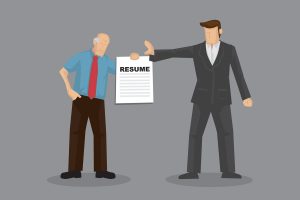
New research shows another barrier being out in the way of older workers continuing to advance or switch their career: good old-fashioned bias. By Tony Watts OBE, co-author of The Midlife Review
I’m not sure where you are with your own career plans, but if they include going for promotion, switching employers or changing roles in the years ahead, and you’re assuming that your gravitas and years of experience will give you an advantage, then you may be disappointed.
A new report conducted by ProAge and 55/Redefined shows that younger HR Professionals are more likely to hire candidates of their own age. In fact, just 24% of HR leaders between ages 25 and 30 said they were very willing or motivated to recruit workers over 55. In contrast, 63% of HR leaders aged 46 to 50 said they were motivated to hire workers aged 55 plus.
It’s more than slightly concerning as, in other areas of recruitment, companies are coming round (albeit slowly in some cases) to the benefits of hiring people that don’t “look just like you…” – acknowledging that having people in a team from diverse backgrounds, ethnicity, gender, orientation, age etc can make an organisation far more resilient as well as more in touch with customers and clients.
This is especially true at a senior, decision-making level where, quite simply, having a diverse range of views available makes you are far less to fall into “group think”, recognise different opportunities and respond to challenges far more effectively.
A deep-rooted problem
However, go beyond the HR bods charged with finding the right people to shortlist, and it’s plain the problem is far wider. Only 30% of employers themselves, according to the new research, said they are “very motivated” to recruit professionals aged 55 or beyond. With smaller companies, the bias is even more stark: only 18% said they look for more senior employees.
Of course, there can be a number of factors at play aside from good old fashioned, uninformed bias. If someone already in a senior role applies for a new role there may be a reluctance for a younger manager to include them in their team because they haven’t managed people older themselves in the past; have done so and had a negative experience; or they simply feel threatened by someone with more experience than them.
Another reason might be the skills set required in the role… perhaps handling the software packages involved might be unfamiliar to the older applicant; there can also be an assumption that an older applicant would be unwilling to go into a more junior or less well-paid role than they are currently occupying; or the recruiter simply assumes they may not put across the right image of a vibrant, thrusting business…
Currently more than 630,000 people aged over 50 are still on furlough and waiting to find out if they have a job to go back to. As the economy stutters back to life post-Covid, especially as furlough subsidies ending bring employment costs into sharp relief, many businesses or cash-strapped public and third sector organisations will undoubtedly be looking to pare staffing – and all the signs are that many older personnel may need to rethink their futures.
Training can be key
One of the issues that holds back many older people when they apply for internal promotions or job changes is a lack of training within an economy where roles are constantly changing, being phased out or introduced as technology and consumer trends evolve. According to recent research by City & Guilds Group, when it comes to formal workplace training, those aged 55 and over are at the highest risk of being left behind – and less employable. Only just over half (53%) have undertaken formal workplace training in the last five years, compared to 67% of 35–54-year-olds and 83% of 18–34-year-olds.
So, is it all doom and gloom? Not necessarily, because according to the ProAge and 55/Redefined report, older workers themselves are far from resigned to finding themselves on the scrap heap through a lack of training. In fact:
- 90% of employees aged 55-65 believe they have transferable skills to move role and/or industry if the employer was prepared to offer technical training.
- 42% of over-55s would consider retraining/reskilling (this increases to 57% of the
unemployed over-55s).
- 49% of over-55s interested in reskilling would investigate doing so with a new
employer.
- 89% of over-55s would be prepared to take a drop in salary to retrain in a new
role/industry – while only 62% of all employers (and only 32% of Public Sector
employers) thought that candidates would be willing to take a salary drop to join
them.
- 25% of the retired respondents would also consider reskilling/retraining to re-enter
the workforce.
The challenge is persuading employers of the merits of training older workers in order to retain their skills, knowledge and experience. But if YOU feel that training might help equip you for a more secure future, perhaps it’s time to ask…
___________________________________________________________________________________
Check out how your retirement plans are going…
If you want to find out how your retirement plans are faring, and if/when you can afford to retire, or how much more you need to save, then why not check out your financial future on the RetireEasy LifePlan site. It takes a few minutes to set your plan up, it’s totally confidential and absolutely no one will try and sell you anything! Moreover, it costs just a few pounds a month to keep tabs on your plans longer term – and you can unsubscribe at any time.
